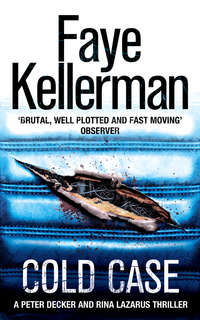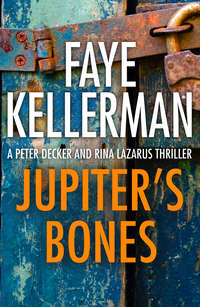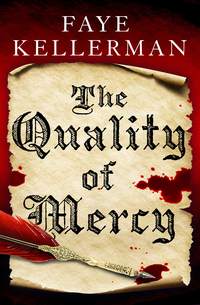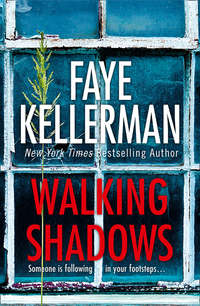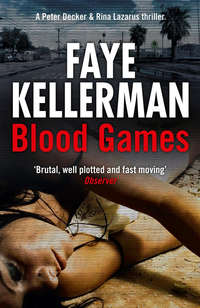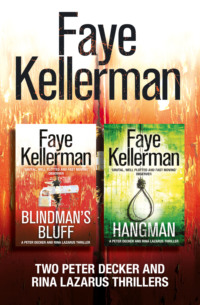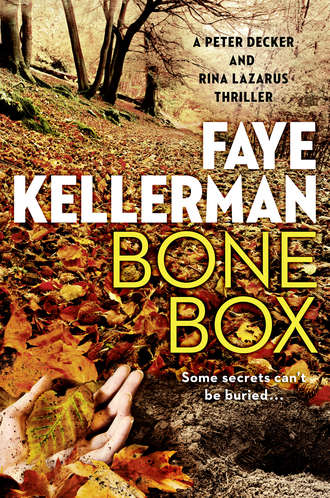
Полная версия
Bone Box
After the items were bagged and tagged, Decker and McAdams drove to the station house. Once there, Decker turned on the computer and read about Delilah Occum: she had disappeared from Clarion College three years ago.
“She was a brunette so she’s definitely in the running. She was last seen wearing a black coat, a red mini dress, and heels.” Decker looked up and directed his question to McAdams. “Did the fabric look red to you?”
“I couldn’t tell a color, pard. Too dirty. The button doesn’t look like it came from a black coat.”
“Which would make sense,” Decker said. “It’s hard to bury a body in winter. The ground is frozen.” A pause. “When did Delilah disappear?”
“Lemme look it up.” McAdams clicked onto her file. “Right after Thanksgiving vacation.”
“I wonder what the temperature was.” Decker clicked the keyboard. “Huh … first snowfall wasn’t until almost Christmas. I suppose theoretically you could bury a body, especially if the forest floor was covered with stuff to keep out the cold.”
McAdams said, “To me, the button looks like it came from a blouse or a shirt.”
“I agree. What about the other college student—Yvette Jones?” Decker brought up the file on his computer. “Also a brunette.”
“So she’s a contender.”
“Yep. Yvette’s roommate remembered seeing her in the morning … she was in the dining hall for lunch—cameras caught her leaving at two-fifteen. Then she went to a lecture at Murphy Hall: Investment for the Socially Conscious. She was caught on camera wearing jeans, a light-colored sweater over a light-colored blouse, and sneakers.”
“The button was light colored.”
“Yes. Yvette was five four, one twenty-six, brown hair, brown eyes. We have our files obviously, but the school didn’t turn them over to GPD until a few days later. I’m sure they also have their own files with their own information. We should find out.”
“Think they’d keep old files like that?”
“If they didn’t, they would be negligent. These are still open cases.” He leaned back in his desk chair. “Let’s see what the coroner has to say. Give him a call. He should have the bones laid out later in the afternoon.”
“He’s in Hamilton right?”
“He is. Do you want to grab lunch before we go? We’ve got time.”
“No, I’m fine. I’m still digesting breakfast.”
“It’s almost noon. What did you eat?”
“Three eggs, bacon, hash browns, orange juice, and three cups of coffee?”
“The Iris Special at Paul’s truck stop?”
“How would you know Paul’s truck stop, Old Man? There isn’t a shred of food that hasn’t been contaminated with bacon.”
“I was called out to the place last winter. Two hyped-up truckers got into it. Nothing serious, mostly tired guys letting off steam, but someone thought it was prudent to call in reinforcements. I’m sure I’d be called down a lot more often if the place had a liquor license.”
“The reason why college kids have passed it up. That and it isn’t in walking distance from the schools.”
“No, it’s definitely not a college hangout. Do you go there a lot?”
“All summer long. Paul’s makes an apple pie to rival my own.”
“Not your usual crowd, Harvard.”
“Some truth to that. The place is packed with long-distance haulers named Billy, Bud, Bubba, Cletus, Dwayne, Jessie, Jimmy, and lots and lots of Juniors. Sometimes the names are followed by Ray, Lee, or Boy as in Jonny Boy or Billy Boy. But the rednecks and I have reached a real truce. They call me Mr. Lawyer and ask me legal questions so that they can sue their employers for workman’s comp. The waitresses flirt with me and call me honey, and I leave them big tips. The place has Wi-Fi. I sit at the counter and surf the Net. Other than your house, it’s my home away from home.”
Chapter Three
Rina was early, but Tilly Goldstein was even earlier. That was a good thing. Vegan Palace was already crowded and it was good that Tilly had snagged a table. The woman had blue eyes, short curly gray hair, and glasses that hung down from a chain around her neck. Today she had on a yellow, summery dress with short sleeves exposing thin arms and baggy skin. Rina slid into the chair opposite Tilly. Immediately they were handed menus by a young woman with blue hair who was studded with piercings and inked with tattoos. She told Tilly and Rina that her name was Sarah and she’d be back with water and pita bread.
When she left, Tilly said, “She has such a pretty face. Why would she want to walk around with pins in her like a voodoo doll? And the tattoos? Do you understand tattoos?”
“Kids get them to be unique. But when I see them, I immediately think of my parents, who were Holocaust survivors with tattooed numbers. What are you going to have?”
“What are you going to have?”
“I was thinking about the tofu curry or the vegan burger deluxe.”
“Get the curry. I’ll get stir-fry. I like soba noodles.”
Ten minutes later, Sarah came over to take the order. They made small talk until the food came. Then Tilly put her napkin on her lap.
“So what’s this about finding a body at Bogat Trail?”
“They found bones. Actually, I found bones.” Rina brought her up to speed. “Of course, the immediate thought was that it might be one of the missing girls from the colleges. Since you’ve been there for a while—”
“Don’t remind me.”
Rina pulled out a small pad. “What can you tell me about them?”
“I remember Delilah better than Yvette because Delilah was more recent. It was very sad. She was coming home from a party about three years ago and never made it to her dorm at Clarion. Her disappearance caused this whole brouhaha about lax campus security especially at night. The colleges agreed to post more guards. The board also instituted this walk-home policy that if anyone—male or female—felt the need to be accompanied anywhere on the campus at any time, day or night, there would be someone available to them.”
“Is the service used?”
“All the time. It was said that Delilah had to be the sacrificial lamb before the colleges wised up that sometimes campuses can be unsafe places.”
“I agree. But it seems like they’d have to hire an awful lot of guards to keep up with the demand.”
“No, no, no. It’s like Uber. We have a huge list of students from all the colleges who are willing to walk other students to and fro for pocket change. A person calls the office and we check around to see who is available at that time. We usually have at least forty to fifty students on call.”
“And how well are the students vetted?”
Tilly looked perturbed. “Honestly, they probably aren’t vetted. But the security office does have a list of the students from the call logs. If there’s a problem, someone knows who was called out.”
“Have there been problems?”
“I haven’t heard, but if there were, I’m sure they’re not publicized.” Tilly dug into her stir-fry. “Hmmm … good.”
“Yeah, the food’s really good. I can’t get my husband interested in vegetarian food.”
“That’s just men,” Tilly said. “You know, your husband could probably talk to the colleges about the Delilah Occum disappearance.”
“I’m sure he will.” Rina smiled. “What do you remember about Yvette Jones?”
“She also disappeared at night. I don’t remember the circumstances, Rina. Just that she never made it back to her dorm room.”
“I heard she was coming back from a lecture.”
“A lecture?”
“Something about socially conscious investing?”
“Ah … that sounds like Hank Carter. He gives free lectures bi-monthly. They’re usually packed.”
“This happened over seven years ago. He was giving lectures back then?”
“He’s been at Morse McKinley for years. I’ve gone to a few of his talks. He’s a great speaker.”
Rina wrote down the name. “When you say packed, like how many people?”
“They’re at Murphy Hall, which holds at least three hundred students. He’s not the only one who gives free talks, but socially conscious investing is his topic. He’s been mining that pipeline for years.”
There was a lull in the conversation as Rina scribbled a few notes.
Tilly said, “Bogat Trail. That isn’t far from town.”
“About fifteen minutes,” Rina looked up. “The hike isn’t exactly strenuous, either. It’s around two miles before you hit a fork. Then there’s a switchback or you can go farther, and I think that one trail is a four-mile loop. I’ve never taken that road. It’s too deep in the woods for my taste.”
“I think you’re fearless just walking out there by yourself.”
“I had a gun in my purse when I found the bones, but to tell you the truth I forgot about it.”
“You carry a gun?”
“It’s for protection, Tilly. The woods have critters. Haven’t you ever read Stephen King?”
Tilly smiled. “You actually know how to shoot a gun?”
“I do.”
“You could actually shoot another human being?”
“I’ve never been tested so I don’t know. I probably should go to the range, though. Hone my skills.”
“I can’t believe you own a gun.”
“My husband is a police officer.”
“Yes, he is. I shouldn’t be surprised. It’s just you’re … we’re Jewish. What do we know from guns?”
“Israel does have an army. And women are drafted. It’s where I first learned how to shoot. My pedigree goes long and deep.”
The bones were assembled on the metal table, disarticulated but arranged as a human skeleton. Decker and McAdams were standing in a small room that was used for hospital autopsies, very different from the multiple-roomed L.A. morgue. What was persistent and all too familiar was the smell—decayed, cloyingly sweet, and medicinal. It was an odor that stayed in the nostrils long after the visit.
Most bodies in hospitals died from natural causes. Decker wondered how many actual murder victims Jerome Donner had dealt with in his career. Not that it mattered that much. It was clear how the victim had died.
Decker said, “The skull is caved in.”
“Blunt force trauma,” Donner told him. “By how severe the skull is depressed, it was more than one blow.”
“Any idea of what type of instrument could have done this?”
“It’s irregular in shape, but repeated strikes could do that. My guess is a rock or a stone maybe. Or even the butt of a gun.”
“So she died of blunt force trauma?” McAdams said.
“That’s the cause of death, yes. The she part? Not so fast.”
“You’re kidding.” McAdams said.
“Look at the pelvis, Detectives. We’ve got a small pelvic outlet, a forward-tilting sacrum, and the anterior view shows an angle of less than ninety degrees. We’ve got a dude.”
A moment of silence, then Decker said, “Well, that certainly changes a few things. What else can you tell us?”
“According to my calculations based on the femur length, I’d say he was easily six feet.”
“To bash someone who tops six feet, it would have to be a tall person,” McAdams said.
Decker said, “Or our victim could have been on his knees.”
“That, too,” McAdams said.
“The trauma was at the lower end of the parietal right above the occiput. More like a swing to the back rather than on top of the head.”
“He was ambushed from behind.”
“Probably. By the way, our victim had thin bones and long fingers … piano fingers.”
“Lanky guy?”
“More lanky than stocky.”
“The skull also has a full set of straight teeth,” Decker said. “Any dental work?”
“Yes, you are lucky because very few kids have cavities anymore with all the sealants. There are two small class-one amalgams. If you have dental records, you can probably do a match with them as well as the roots of the teeth.”
“Okay. Do you have an approximate age?”
“Early twenties to mid-twenties by the skull sutures and the teeth. See, we have two erupted third molars and these two in the mandible. Those puppies are impacted. And you’re right. The teeth are aligned, indicating good genetics or good dental care.”
“Race?”
“Spatulate teeth … no flaring of the nostrils. European. Better known as Caucasian.”
“A white male with long, thick hair.” Decker raised a finger. “Could be why we only found a single earring—a small, silver hoop. I looked for the mate, but when I didn’t find it, I figured it was lost during a struggle.”
“He could have been gay,” McAdams said.
Donner said, “Maybe. Look at the nails on the fingers and toes. There’s some keratin left on the digits.”
Decker and McAdams leaned over. The tips had a purple glow to them.
“Nail polish,” Decker said. “Any idea how long he’s been in the ground?”
“It’s really hard to date once the bones have been stripped of the meat. But since there’s still a lot of hair and a little nail polish, I’d say probably less than ten years. If you get some possibilities, we can match the dental records.”
Decker looked at his list. Identifying the body was the first order of business.
Most of the missing people were female between the ages of eighteen and forty-five. But there were a few Caucasian males in the proper age range. Two had been students at the colleges. If none of those fit the description; he’d have to fan out the search. The young man could have been from anywhere and dumped in the woods. Worst-case scenario, if they didn’t get an ID, it was possible to do a forensic reconstruction of the face based on the bony landmarks.
But he wasn’t complaining too much, because he had something to work with. The height, the age, the long hair, the earring, and the purple nail polish were a pretty distinctive combination. Not too many edgy young people lived in town. The colleges were a car ride away. It was as good a place as any to start.
Chapter Four
Fourteen years ago, Byron Henderson, a twenty-one-year-old member of the wrestling team, disappeared from Duxbury College. He went riding on his bike and never came back. He had been five ten with a stocky build and short curly hair, and since he didn’t match the physical description, Decker ruled him out.
Kneed Loft student Kirk Landry had been nineteen when he disappeared after attending a party eleven years ago. He’d been very drunk and it was theorized that he might have fallen through the ice in one of the many numerous ponds and lakes in the Greenbury woodlands. When springtime came and there was still no sign of the boy, people gave up the search. He had been short with thinning hair: not Decker’s current set of bones.
“What’s the next step?” McAdams said.
“I should get dental records of the two boys just to make certain it’s not one of them.” Decker shook his head. “I hate that. It panics the family and then if it’s not him, they crash. I’ll put something over the wire, also. This isn’t going to be a quick resolve. You’re back in school soon. You don’t have to concern yourself with this.”
McAdams thought a moment. “You know—with the long, long hair and the nail polish—I can call up the LGBT Center in the colleges. I’m not saying our John Doe is gay, but we’ve got to start somewhere.”
“He doesn’t fit the description of any of our missing boys.” Decker stood up. “What the hey. It’s a ten-minute walk to the colleges. The weather is beautiful. Your idea is worth a shot.”
After Labor Day, Greenbury started gearing up for the cold weather. No more picnics, parades, or lazy days listening to impromptu acts playing in the park’s bandstand. Instead of swimsuits and shorts, the boutiques’ window displays featured the latest styles in sweaters, parkas, and ski-wear. Although autumn was still weeks away, all the local coffee shops and supermarkets featured anything with pumpkin.
Walking the grounds of the Five Colleges of Upstate, it seemed to Decker that more students were sprawled out on the lawns than learning in the classrooms. The consortium sat on a sizable swath of acreage featuring manicured lawns and wooded land, all of it walking distance from the town of Greenbury. Each institution had its own dean, its own professors, its own campus and dorms, and its own identity. Duxbury was the oldest, a top-tier liberal arts college akin to Amherst or Williams with architecture that would blend into any Ivy League university. Clarion Women’s College was built in the 1920s with scaled-down brick federalist buildings adorned with hints of art deco. Morse McKinley was the government/economics college built after World War II. Students were taught in functional classrooms that sat in functional structures. The residence halls looked more like dingbat apartment buildings than college dorms. Kneed Loft was the smallest and most bunker-like of the five colleges. It specialized in math and sciences and engineering. Littleton, built in the ’60s, was the art and theater college. In its hallowed halls and environs, students grew their own kale, squeezed their own apple cider from the college orchard, and raised sheep for wool.
The clubs, associations, and student centers were more storefronts than actual buildings, and all of them were located within a mile from one another. Most of them were considered Five C organizations, which meant that anyone from any of the colleges could join. There were dozens of places to find affiliation and camaraderie, and the LGBT Center was just one among many. The sign had been up for ages and someone had added a Q in bold, black marker after the T.
As they walked into the room, a tiny bell rang. It was stuffy inside because it was still warm outside, and the place didn’t have air-conditioning. Several fans in the corner were blowing tepid air. The space held a large dining room table topped with dozens upon dozens of pamphlets dealing with everything from sexual identity—Was it even necessary to have one?—to safe sex that will rock your world. A moment later, a petite girl wearing shorts and a T-shirt strolled into the area from a back room. She had blue eyes and a pixie haircut. She stuck out a manicured hand, nails coated with pink polish.
“Arianna Root.” She shook McAdams’s hand first and then Decker’s. “How nice of you to bring your son into the center. It shows a real willingness to be accepting. And I want you both to know that the Five Colleges are among the most liberal and tolerant colleges in the states. You won’t have any problems here, I assure you. How can I help you specifically?”
Decker looked at McAdams, who said, “He’s not my father, and I’m not gay. But don’t be embarrassed. It isn’t the first time that someone has made either of those mistakes.” He pulled out his identification.
Arianna’s expression went from cheerful to suspicious in a nanosecond. “You’re the police?”
“I am,” McAdams answered. “We both are. I’m Detective McAdams. This is Detective Decker—”
“Wait here a second.” Arianna disappeared and came out with reinforcements. His name was Quentin Lewis. He looked to be around twenty with short hair, brown eyes, and dozens of pieces of ear jewelry—rings, studs, and cuffs. He was slight of build and also wore pink nail polish.
After introductions were made again, Decker got down to business. “Do either of you know what’s happening up on Bogat Trail?”
“I’m not even aware of a Bogat Trail,” Quentin said. “I’m not much of a hiker.”
McAdams explained the situation. “We have no idea if the guy was gay or not but because he had very long hair and an earring and nail polish, we thought we’d talk to someone at the center first. We’re not biased. We don’t need to be woke. But we have to start somewhere.”
“What was the color of the polish again?” Arianna asked.
“The nails had a purplish hue that has probably worn off over time.”
“So it was dark when it was first applied?”
“Probably.”
“Our signature color is bubblegum pink so if he wanted to be identified with the center, his nails wouldn’t have been dark. Deep purple nail polish was all the rage about five years ago. It sounds like Vex or Vampire. How old is the body?”
“To be determined,” McAdams said. “But it could be five years old.”
“Obviously, I wasn’t here five years ago.”
Decker said, “Is there anyone who was here five years ago?”
“No, this is a student-run center,” Lewis said.
“What about faculty members?”
“The center is for the students,” Arianna said. “We do have LGBT faculty who are supportive and come to our events as a show of solidarity. But we run the show.”
“But you might have faculty involved with the center for a long time?”
Quentin nodded. “Sure.”
Decker said, “Could you supply us with some names?”
“I don’t know … privacy and all that.” Quentin turned to Arianna. “What do you think?”
“I think we should contact the professors and ask if they want to help. This is not our decision to make. Sorry.”
At that moment, a fortyish man in with salt-and-pepper hair walked into the center. He looked at Decker and McAdams and then at Quentin and Arianna. “Is everything okay?”
“We’re from Greenbury Police Department.” Decker showed the man his badge. “And you are?”
“Jason Kramer. I’m a professor of psychology at Duxbury. Why are you here?”
“We found the bony remains of a young man yesterday afternoon near Bogat Trail. We’re trying to identify him. His physical description doesn’t jibe with any of the young men who disappeared from the colleges in the last fifteen years, but he could have been a former college student. We’re at the very early stages of our identification. We’re asking for help.”
“Is there something that makes you think the man was gay?”
“Long hair, earrings, nail polish. It’s just one avenue we’re exploring.”
“If he wasn’t a student at the colleges, why would he be associated with the center?”
“Students come and go. They transfer to other colleges, some transfer to here. And they graduate and revisit their old haunts.” McAdams smiled. “Like Detective Decker said, we’re at the very early stages and we’re trying to work with whatever information that we have available.”
Kramer pursed his lips. “Describe him to me again?”
Decker said, “Long, thick brown hair, one silver earring. He wore purple nail polish on his fingers and toes.”
Arianna said, “You mean you have just bones, nails, and hair?”
“Flesh goes, hair and nails often remain long after.”
Kramer said, “And how old are the remains?”
“I don’t know. We suspect within the last ten years, maybe. Or do you mean the age of the person who died?”
“Both, I guess.”
“The bones are of a man in his early twenties: a tall young man, six one or two. The coroner said he had long fingers. He called them piano fingers.” Decker could see a light behind the man’s eyes. “He sounds familiar to you, Dr. Kramer?”
“Jason is fine.” He sighed. “There was a student here around six or seven years ago. Lawrence Pettigrew. Brilliant guy. He went to Morse McKinley—PEG major.”
“What’s that?”
“Political science, economics, and government,” Quentin answered. “You have to apply to be in the major. Seven years ago was before my time.”
Kramer said, “He played a concert at the Christopher Street Gay Pride Fete while he was here.”
“I was a junior in high school,” Arianna said.
The professor said, “Lawrence was always on. He was exuberant—the proverbial life of the party. He had long, long hair, but it was blond when I knew him. He dressed in costumes rather than clothes: long silk scarves, crazy hats, patterned pants and shirts that purposely clashed. He wore lots of jewelry—rings, earrings, necklaces. I don’t recall the nail polish.”
Decker wrote down the information on his pad. “Would you know where I could find him? Just to rule him out?”
“No, but the administration might know.”
“And would you know where I could get a picture of him?”
“No idea.”
“Do you remember anything else about his face? Eye color, the shape of the face? Beard or mustache? Moles? Tattoos?”




